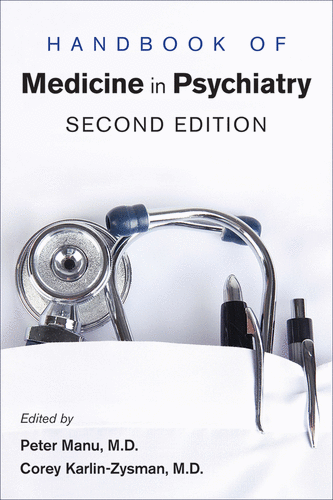Handbook of Medicine in Psychiatry, 2nd ed.

For anyone who has worked in an inpatient psychiatric unit, it comes as no surprise that many patients in this setting have serious medical comorbidities. As many as three-quarters of individuals with a serious psychiatric illness also carry a chronic medical diagnosis (1), and according to a single study, nearly a third of consecutively screened patients admitted to an inpatient psychiatric unit also had a physical illness, of which 3.5% had physical illnesses that likely exacerbated their psychiatric condition (2). Despite these sobering statistics, psychiatric residency training in the United States has progressively decreased time learning general medicine (3), leaving practicing psychiatrists to rely primarily on their medical school training when faced with medical issues in their patients.
In this setting, Drs. Manu and Karlin-Zysman, internists in an academic medical center, have introduced the second edition of the Handbook of Medicine in Psychiatry, with the goal of addressing “the realities confronting clinicians who work in self-standing, inpatient psychiatric settings” (pp. xxvii). The volume is organized into 40 brief (generally 4–11 pages) chapters and seven parts, including emergency medical conditions (sudden death, cardiac arrest, and respiratory failure), abnormal vital signs, common somatic symptoms (e.g., chest pain), metabolic emergencies, serious psychotropic side effects, management of acute behavioral disturbances (e.g., delirium), and assessment of medical risk. Chapters, authored by academic internists and psychiatrists, include descriptions of each condition’s clinical presentation, differential diagnosis, risk stratification, evaluation, and management, often with clear tables and flowcharts that highlight key concepts. For example, the chapter covering falls and head trauma includes a table of risk factors associated with falls, flow charts that help guide pre- and post-fall assessments, and the Glasgow Coma Scale for quick reference. Each topic includes relevant citations from peer-reviewed sources, which have been revised to reflect updates since the publication of the first edition of this volume.
Unlike general medical texts and reference books, the Handbook expends minimal space on etiology and pathophysiology, emphasizing instead practical methods of assessment and management. This approach is helpful for a quick reference on the wards, but also as a concise refresher for psychiatrists seeking to jog their memory of general medical knowledge. Nonetheless, as expected for a volume incorporating 63 authors, chapters are sometimes uneven in their level of detail. For instance, the chapter covering hypertension only includes a list of antihypertensive drug classes with general guidance for choosing among them; in contrast, the chapter covering thyroid disorders (seen much less frequently than hypertension among psychiatric patients), includes a detailed series of flow charts that guide laboratory assessment and pharmacologic management of hypo- and hyperthyroidism. In addition, certain medical conditions receive little-to-no attention, such as gynecologic issues and medical concerns in patients receiving hemodialysis.
Overall, this updated edition of the Handbook serves a crucial role as both an accessible white-coat reference and a source for need-to-know medical knowledge among inpatient psychiatrists. For psychiatric trainees in particular, this volume consolidates and organizes essential information in the sea of topics covered in online resources such as Epocrates and UpToDate.
1. : Prevalence, severity, and co-occurrence of chronic physical health problems of persons with serious mental illness. Psychiatr Serv 2004; 55:1250–1257 Crossref, Google Scholar
2. : Medical disorders among patients admitted to a public-sector psychiatric inpatient unit. Psychiatr Serv 2002; 53:1623–1625 Crossref, Google Scholar
3. : Training psychiatrists in nonpsychiatric medicine: What do our patients and our profession need? Acad Psychiatry 2009; 33:181–186 Crossref, Google Scholar



